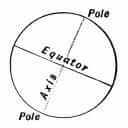Down
| 1. | the study of the earth's crust, strata, and especially rocks. |
| 2. | the low land between hills. |
| 3. | the parallel of latitude that is south of the equator. Land lying near this imaginary line stays warm all year long. (3 words) |
| 4. | the parallel ring of latitude that limits the area around the South Pole which has midnight sun. The sun doesn't rise on the summer solstice, and it doesn't set on the winter solstice. It is near the South Pole. (2 words) |
| 8. | a portion of land surrounded on three sides by water. Florida is an excellent example of this. |
| 9. | one of the seven very large land masses of the world. |
| 10. | imaginary circle around the Earth, passing through the poles and cutting the equator at right angles. |
| 12. | A chain or set of islands grouped together |
| 13. | Half of the earth's surface. There are four possible halves, depending on which way you divide the Earth, Northern and Southern (divided by the equator) and the Eastern and Western (divided by the Prime Meridian and 180�) |
| 14. | a deep valley with high, steep slopes. It often has a stream running through it. There is a grand one in the western U.S. |
|
|
Across
| 1. | part of an ocean or sea that extends into a land mass. A large one exists south of the U.S. and east of Mexico. |
| 5. | the parallel ring of latitude where the Sun does not set on the day of the summer solstice, and does not rise on the day of the winter solstice. It is near the North Pole. (2 words) |
| 6. | a large body of salt water. The earth contains four that together cover 75% of our planet's surface. |
| 7. | the parallel of latitude that is north of the equator. Land lying near this imaginary line stays warm year-round. (3 words) |
| 11. | The shape or configuration of the earth's surface |
| 16. | A large flat-topped but steep-sided landform found in western portions of the U.S., but not in the East. The name is Spanish for "table." |
| 17. | dry land that receives very little rainfall and has little vegetation. |
|





































































































































































































































































































































































































































































































































































































































































